Rio Tinto Bundle
Who Really Controls Rio Tinto?
Understanding the intricate web of Rio Tinto SWOT Analysis and its ownership is key to grasping its global impact. From its humble beginnings to its current status as a mining titan, the evolution of Rio Tinto's ownership structure reveals a fascinating story of power, influence, and strategic maneuvering. The recent buzz around potential mergers further highlights the importance of knowing who owns the company and how that shapes its future.
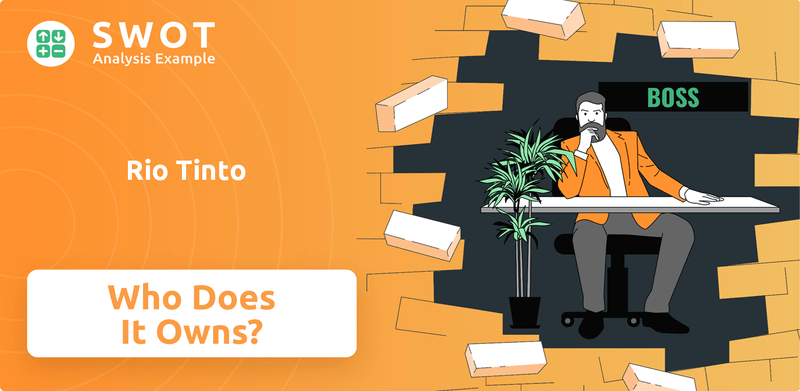
This deep dive into Rio Tinto's ownership will explore the major shareholders, the influence of the Board of Directors, and the implications of its dual-listed structure. Discover who is the CEO of Rio Tinto and how the company's ownership impacts its financial performance and strategic direction. We'll examine the Rio Tinto company history, its stock price today, and how you can invest in Rio Tinto, providing a comprehensive overview of this critical player in the global mining industry.
Who Founded Rio Tinto?
The story of Rio Tinto ownership began on March 29, 1873, with the acquisition of the Rio Tinto mines from the Spanish government. This pivotal moment, which cost approximately £3.68 million (ESP 92.8 million), marked the formal establishment of the Rio Tinto company.
A syndicate of British and European investors spearheaded the purchase, with Hugh Matheson, from Matheson & Company, taking the lead as the first chairman. The initial ownership structure saw Deutsche Bank holding 56%, Matheson & Company with 24%, and Clark, Punchard and Company at 20%.
The Spanish government's relinquishment of all royalty claims was a key element of the deal. This strategic move set the stage for the rapid expansion of mining operations and the adoption of advanced techniques, quickly establishing the company as the world's foremost copper producer within five years. The Rothschild family's significant investment in the late 1880s further shaped the company's early trajectory.
The initial ownership structure of the Rio Tinto mining company was designed to facilitate rapid growth and global expansion. This strategic approach, led by key investors, enabled the company to quickly become a leader in the copper industry.
- The early ownership structure included Deutsche Bank, Matheson & Company, and Clark, Punchard and Company.
- The Rothschild family became a significant shareholder in the late 1880s.
- The acquisition from the Spanish government, which included relinquishing royalty claims, was critical to the company's success.
- These early decisions set the foundation for Rio Tinto's future as a global mining giant.
Rio Tinto SWOT Analysis
- Complete SWOT Breakdown
- Fully Customizable
- Editable in Excel & Word
- Professional Formatting
- Investor-Ready Format
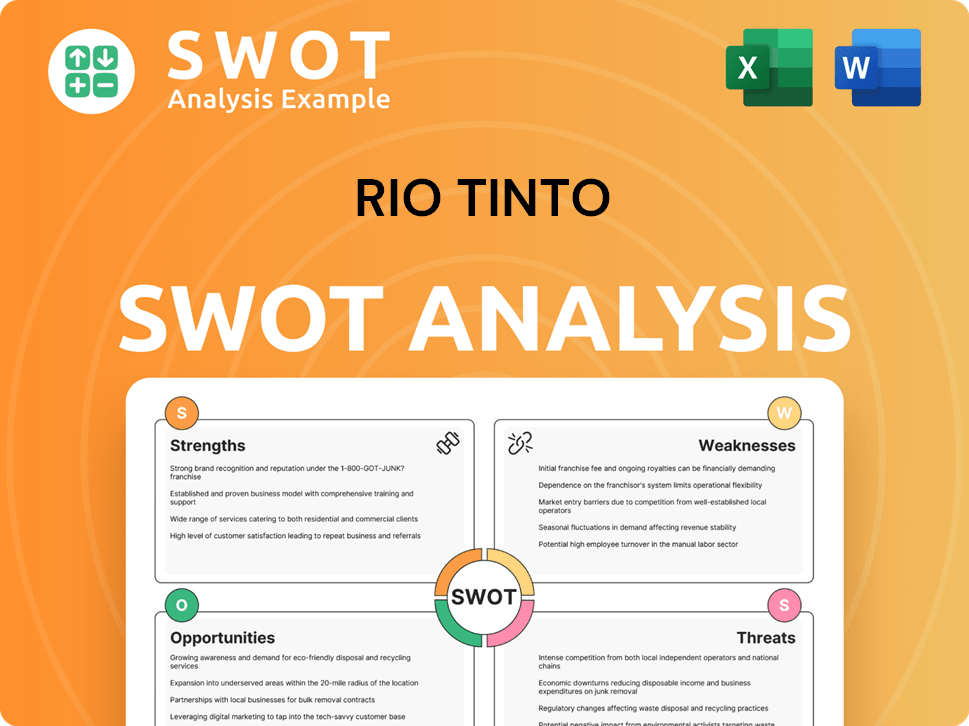
How Has Rio Tinto’s Ownership Changed Over Time?
The ownership structure of the Rio Tinto company has evolved significantly since its initial public offering (IPO) for Rio Tinto (RTNTF) on September 19, 1962. A pivotal moment occurred in 1962 when the original Rio Tinto Company merged with the Australian firm Consolidated Zinc, forming the Rio Tinto – Zinc Corporation (RTZ) and its main subsidiary, Conzinc Riotinto of Australia (CRA). This merger expanded Rio Tinto's assets and opportunities. CRA focused on Australasian operations, while RTZ handled the rest of the world. In December 1995, RTZ and CRA unified, operating as a single entity with a common board, although they maintained separate shareholder lists in the UK and Australia.
Further streamlining occurred in June 1997, when RTZ Corporation became Rio Tinto plc and CRA Limited became Rio Tinto Limited, collectively known as the Rio Tinto Group. This dual-listed company (DLC) structure aimed to provide shareholders of both companies with equivalent economic interests and ownership rights as if they held shares in a single entity. Key acquisitions, such as US Borax in 1968, Kennecott Utah Copper and BP's coal assets in 1989, and Alcan Inc. in 2007, have shaped Rio Tinto's strategy and its position in the global market, making it a leader in various mineral productions.
| Event | Date | Impact on Ownership |
|---|---|---|
| Merger of Rio Tinto and Consolidated Zinc | 1962 | Formation of RTZ and CRA, expansion of asset base. |
| Unification of RTZ and CRA | December 1995 | Single entity with common board, separate shareholder lists. |
| RTZ Corporation becomes Rio Tinto plc, CRA Limited becomes Rio Tinto Limited | June 1997 | Establishment of a dual-listed company (DLC) structure. |
As of June 1, 2025, the institutional ownership of Rio Tinto stands at 8.56%, with insider ownership at 0.10%. The float percentage of total shares outstanding is 88.75%. Major institutional investors include BlackRock, Inc. (approximately 6.8%) and The Vanguard Group, Inc. (approximately 4.5%). Aluminum Corporation of China (Chinalco), through Shining Prospect Pte Ltd, is noted as the largest single shareholder with approximately 11.6% ownership. Public companies and individual investors collectively own approximately 92.02% of Rio Tinto Plc (RIO) stock. Understanding the Competitors Landscape of Rio Tinto is crucial for grasping its market position.
The ownership of Rio Tinto has evolved through mergers and acquisitions, creating a complex structure.
- Institutional investors hold a significant portion of the shares.
- Chinalco is the largest single shareholder.
- The DLC structure aims to give shareholders equal rights.
- The company's history includes key acquisitions.
Rio Tinto PESTLE Analysis
- Covers All 6 PESTLE Categories
- No Research Needed – Save Hours of Work
- Built by Experts, Trusted by Consultants
- Instant Download, Ready to Use
- 100% Editable, Fully Customizable
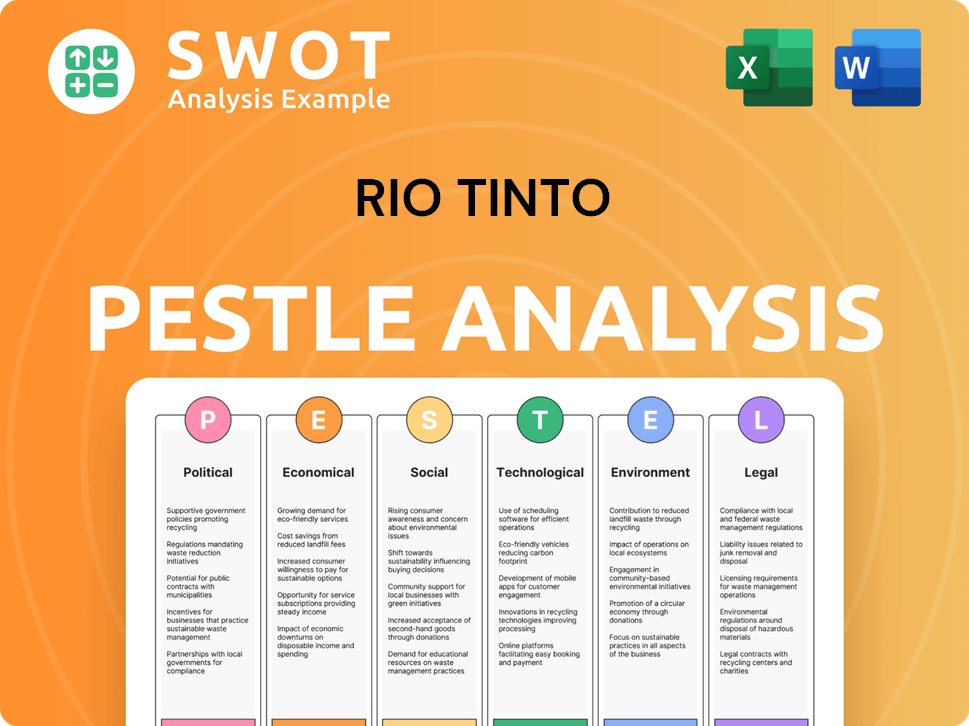
Who Sits on Rio Tinto’s Board?
The governance of the Rio Tinto company is managed through a dual-listed company (DLC) structure. This structure means that both Rio Tinto plc and Rio Tinto Limited share the same board of directors, ensuring a unified strategic approach. As of the end of 2024, the Chairman is Dominic Barton, and Jakob Stausholm serves as the Chief Executive. This setup is designed to provide shareholders of both companies with equivalent economic interests and ownership rights. Decisions on critical issues affecting shareholders of both entities are presented as Joint Decision Matters, voted upon by shareholders from both companies as a joint electorate.
The Board of Directors plays a pivotal role in the strategic direction and oversight of the company. In December 2024, there was a call from Palliser Capital, supported by other shareholders, for Rio Tinto to unify its DLC structure. They submitted a resolution for an independent review of the structure. However, at the annual general meetings held on April 3, 2025, in London and May 1, 2025, in Perth, the shareholders voted against this proposal, aligning with the Board's recommendation. The Board regularly reviews the DLC structure and completed a comprehensive review in 2024, with external expert advice.
| Role | Name | As of |
|---|---|---|
| Chairman | Dominic Barton | End of 2024 |
| Chief Executive | Jakob Stausholm | End of 2024 |
| Board of Directors | Same for both Rio Tinto plc and Rio Tinto Limited | Ongoing |
The current insider ownership at Rio Tinto is approximately 0.10%. This indicates that the direct stake held by board members and company executives is relatively small compared to the holdings of institutional and public investors. Understanding the Growth Strategy of Rio Tinto also provides insights into how the board's decisions impact the company's overall direction and shareholder value.
The dual-listed company structure ensures unified strategic direction.
- Dominic Barton is the Chairman, and Jakob Stausholm is the Chief Executive.
- Shareholders voted against unifying the DLC structure in 2025.
- Insider ownership is approximately 0.10%.
- The board's decisions significantly influence the company's direction.
Rio Tinto Business Model Canvas
- Complete 9-Block Business Model Canvas
- Effortlessly Communicate Your Business Strategy
- Investor-Ready BMC Format
- 100% Editable and Customizable
- Clear and Structured Layout
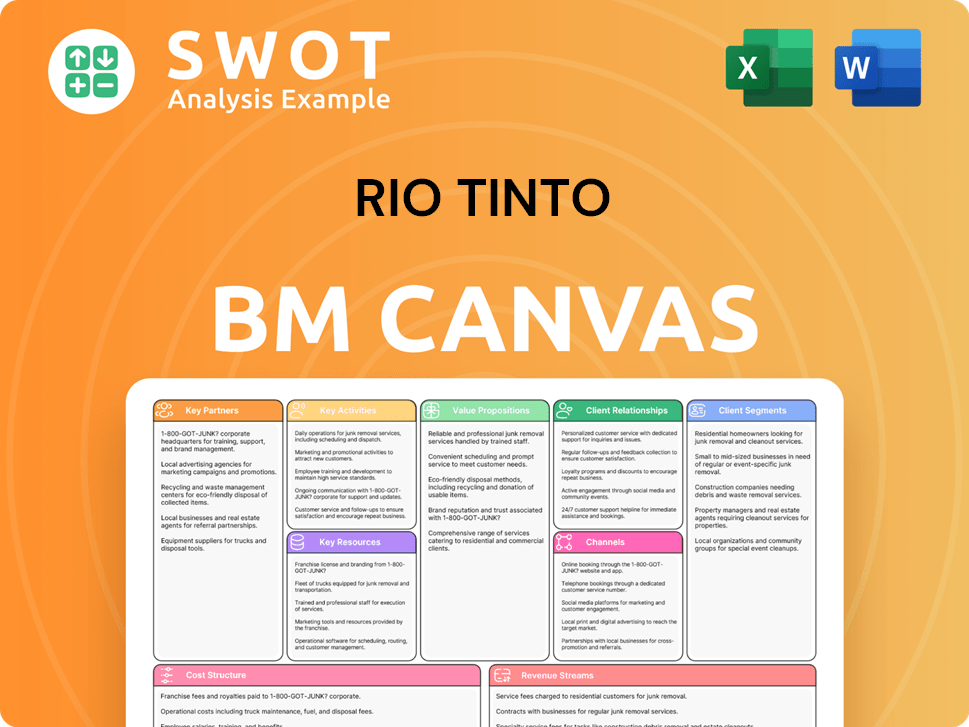
What Recent Changes Have Shaped Rio Tinto’s Ownership Landscape?
Over the past few years, the Rio Tinto company has been actively involved in strategic acquisitions, significantly impacting its ownership profile. In March 2022, the company acquired Rincon Mining's lithium project in Argentina for $825 million. Further expansion occurred in July 2023 with a $27.6 million investment in Sovereign Metals. A major development was the announcement in October 2024 of the intent to acquire Arcadium Lithium for $6.7 billion, which closed in March 2025, establishing a dedicated lithium unit within Rio Tinto mining. These moves reflect a strategic focus on securing critical minerals.
Recent developments also include the full acquisition of New Zealand Aluminium Smelters (NZAS) in May 2024, after buying Sumitomo Chemical Company's 20.64% interest. Simultaneously, Rio Tinto increased its stake in Boyne Smelters Ltd (BSL) to 61.85%. In November 2024, the company increased its stake in Energy Resources of Australia (ERA) to over 98%, planning a compulsory acquisition of the remaining shares to focus on rehabilitation. These acquisitions and increased ownership stakes show a trend of consolidation and strategic alignment within the company.
| Acquisition/Investment | Date | Details |
|---|---|---|
| Rincon Mining Lithium Project | March 2022 | Acquired for $825 million |
| Sovereign Metals Stake | July 2023 | 15% stake for US$27.6 million |
| Arcadium Lithium | Closed March 2025 | Acquired for US$6.7 billion |
| New Zealand Aluminium Smelters (NZAS) | May 2024 | Full Ownership |
| Boyne Smelters Ltd (BSL) | May 2024 | Increased stake to 61.85% |
| Energy Resources of Australia (ERA) | November 2024 | Increased stake to over 98% |
A notable trend in the mining industry is consolidation, driven by the rising demand for critical minerals. There was speculation in late 2024 and early 2025 about a potential merger between Glencore and Rio Tinto, which could have created a mining giant exceeding $140 billion in market capitalization. This speculation followed the departure of CEO Jakob Stausholm, with reports suggesting strategic differences on M&A approach. Despite these discussions, shareholders rebuffed calls from Palliser Capital in May 2025 to ditch Rio Tinto's primary London listing and unify its dual-listed structure. The Rio Tinto shareholders saw an underlying EBITDA of $23.3 billion for the year ended December 31, 2024, with a profit after tax attributable to owners of Rio Tinto at $11.6 billion. For more insights into the company's financial structure, consider reading about the Revenue Streams & Business Model of Rio Tinto.
Rio Tinto operates under a dual-listed structure, with listings on both the London Stock Exchange and the Australian Securities Exchange. This structure impacts how Rio Tinto ownership is distributed among different shareholder groups.
Major institutional investors hold significant stakes in Rio Tinto. Understanding the key shareholders provides insight into the company's strategic direction and governance. Identifying Rio Tinto's major shareholders list is crucial.
Rio Tinto stock performance reflects market sentiment and investor confidence. Analyzing the Rio Tinto share price analysis helps assess the company's valuation and future prospects. Investors can explore how to invest in Rio Tinto.
The Rio Tinto board of directors plays a crucial role in overseeing the company's operations and strategic decisions. Understanding the board's composition and influence is vital for assessing Rio Tinto ownership and control.
Rio Tinto Porter's Five Forces Analysis
- Covers All 5 Competitive Forces in Detail
- Structured for Consultants, Students, and Founders
- 100% Editable in Microsoft Word & Excel
- Instant Digital Download – Use Immediately
- Compatible with Mac & PC – Fully Unlocked
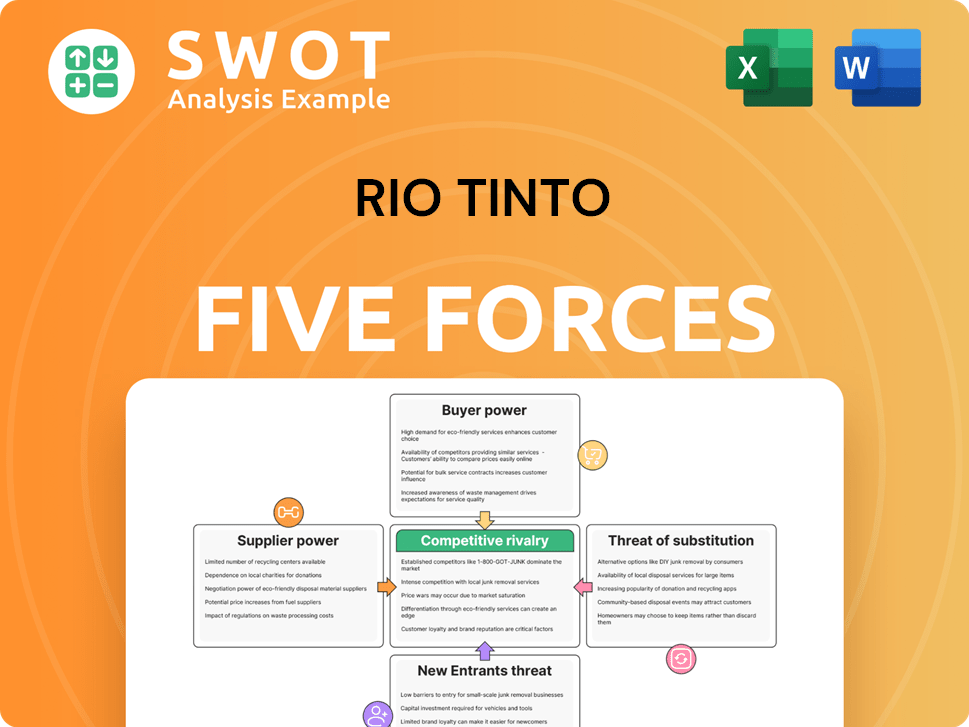
Related Blogs
- What are Mission Vision & Core Values of Rio Tinto Company?
- What is Competitive Landscape of Rio Tinto Company?
- What is Growth Strategy and Future Prospects of Rio Tinto Company?
- How Does Rio Tinto Company Work?
- What is Sales and Marketing Strategy of Rio Tinto Company?
- What is Brief History of Rio Tinto Company?
- What is Customer Demographics and Target Market of Rio Tinto Company?
Disclaimer
All information, articles, and product details provided on this website are for general informational and educational purposes only. We do not claim any ownership over, nor do we intend to infringe upon, any trademarks, copyrights, logos, brand names, or other intellectual property mentioned or depicted on this site. Such intellectual property remains the property of its respective owners, and any references here are made solely for identification or informational purposes, without implying any affiliation, endorsement, or partnership.
We make no representations or warranties, express or implied, regarding the accuracy, completeness, or suitability of any content or products presented. Nothing on this website should be construed as legal, tax, investment, financial, medical, or other professional advice. In addition, no part of this site—including articles or product references—constitutes a solicitation, recommendation, endorsement, advertisement, or offer to buy or sell any securities, franchises, or other financial instruments, particularly in jurisdictions where such activity would be unlawful.
All content is of a general nature and may not address the specific circumstances of any individual or entity. It is not a substitute for professional advice or services. Any actions you take based on the information provided here are strictly at your own risk. You accept full responsibility for any decisions or outcomes arising from your use of this website and agree to release us from any liability in connection with your use of, or reliance upon, the content or products found herein.